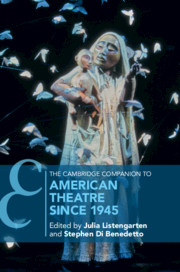Book contents
- The Cambridge Companion to American Theatre since 1945
- Cambridge Companions to Theatre and Performance
- The Cambridge Companion to American Theatre since 1945
- Copyright page
- Contents
- Notes on Contributors
- Acknowledgments
- Introduction
- Part I Commercial and Mainstream Theatre
- Part II Regional Theatre Movement
- Part III Experimental Theatre and Other Forms of Entertainment
- Chapter 8 Experimental Collectives of the 1960s and Their Legacies
- Chapter 9 Post-Avant-Garde Theatre
- Chapter 10 Populist Provocations and Commercial Cavalcades
- Index
- References
Chapter 9 - Post-Avant-Garde Theatre
from Part III - Experimental Theatre and Other Forms of Entertainment
Published online by Cambridge University Press: 20 August 2021
- The Cambridge Companion to American Theatre since 1945
- Cambridge Companions to Theatre and Performance
- The Cambridge Companion to American Theatre since 1945
- Copyright page
- Contents
- Notes on Contributors
- Acknowledgments
- Introduction
- Part I Commercial and Mainstream Theatre
- Part II Regional Theatre Movement
- Part III Experimental Theatre and Other Forms of Entertainment
- Chapter 8 Experimental Collectives of the 1960s and Their Legacies
- Chapter 9 Post-Avant-Garde Theatre
- Chapter 10 Populist Provocations and Commercial Cavalcades
- Index
- References
Summary
The American avant-garde theatre of the post-World War II era, with its underlying engagement with the betterment of society and a foregrounding of the body, either solo or collective, could be seen as an extension of the Romantic project. But by the 1990s, the ideas and impulses that fueled its artistic drive seemed to dissipate as it became subsumed by Postmodernism and also by popular culture. The avant-garde energies and impulses did not disappear, however, and increasingly they could be found in the theatre’s eager adoption and exploration of new technologies and digital media. By mediatizing live performance, the new technologies often became co-equal with, or dominant over, the human actors. Beginning with groups and individual artists such as Squat, The Wooster Group, and Laurie Anderson and continuing through The Builders Association, Big Art Group, and Annie Dorsen, among many others, a post-avant-garde has emerged that does not fetishize technology, but rather embraces it as a tool to alter consciousness—much as the historical avant-garde did—and to expand the possibilities and definitions of performance.
Keywords
- Type
- Chapter
- Information
- The Cambridge Companion to American Theatre since 1945 , pp. 228 - 251Publisher: Cambridge University PressPrint publication year: 2021

